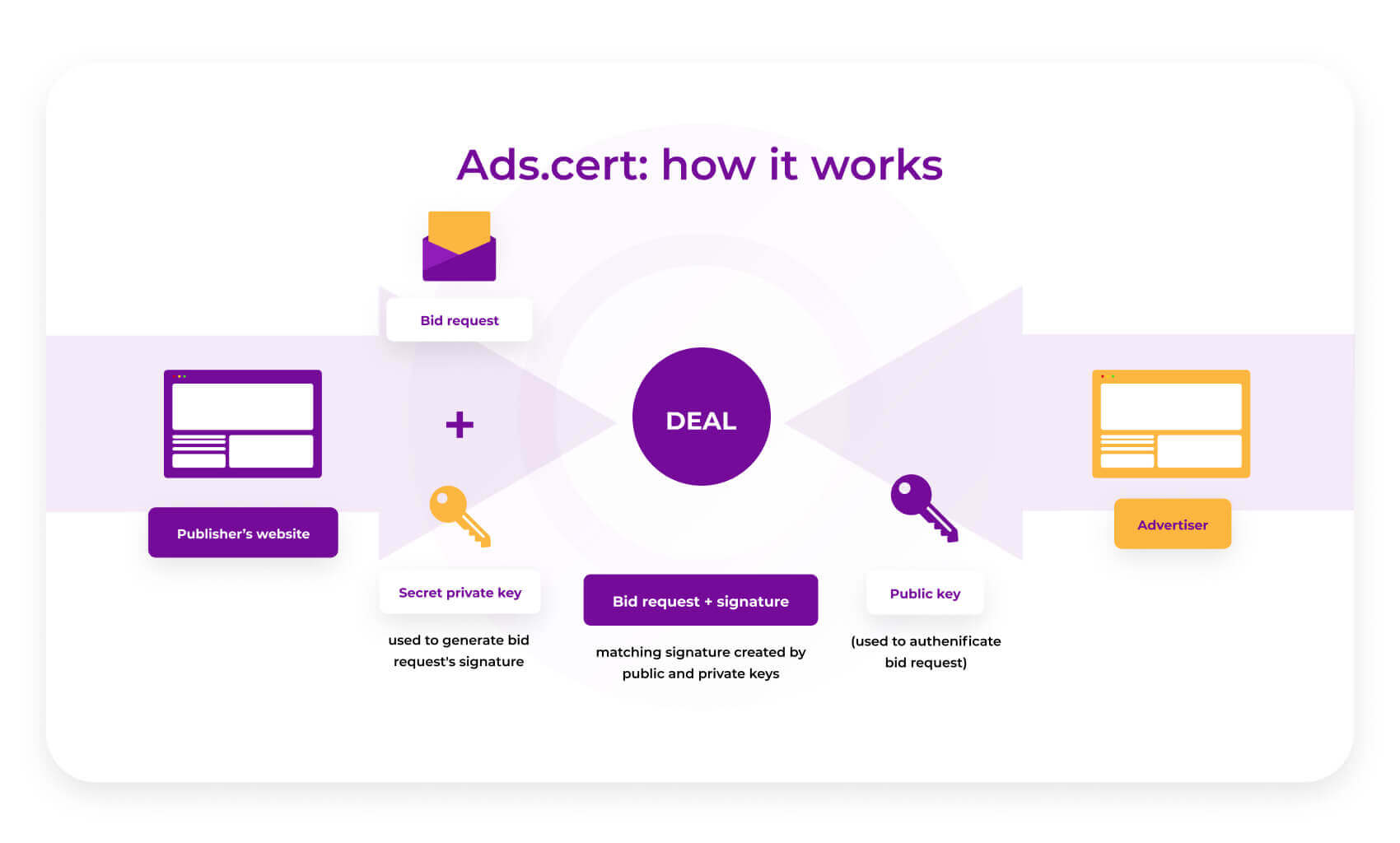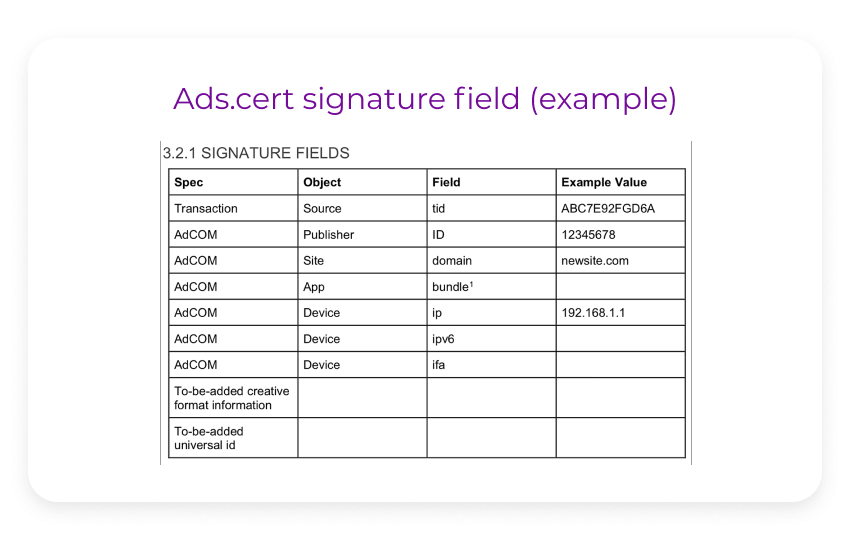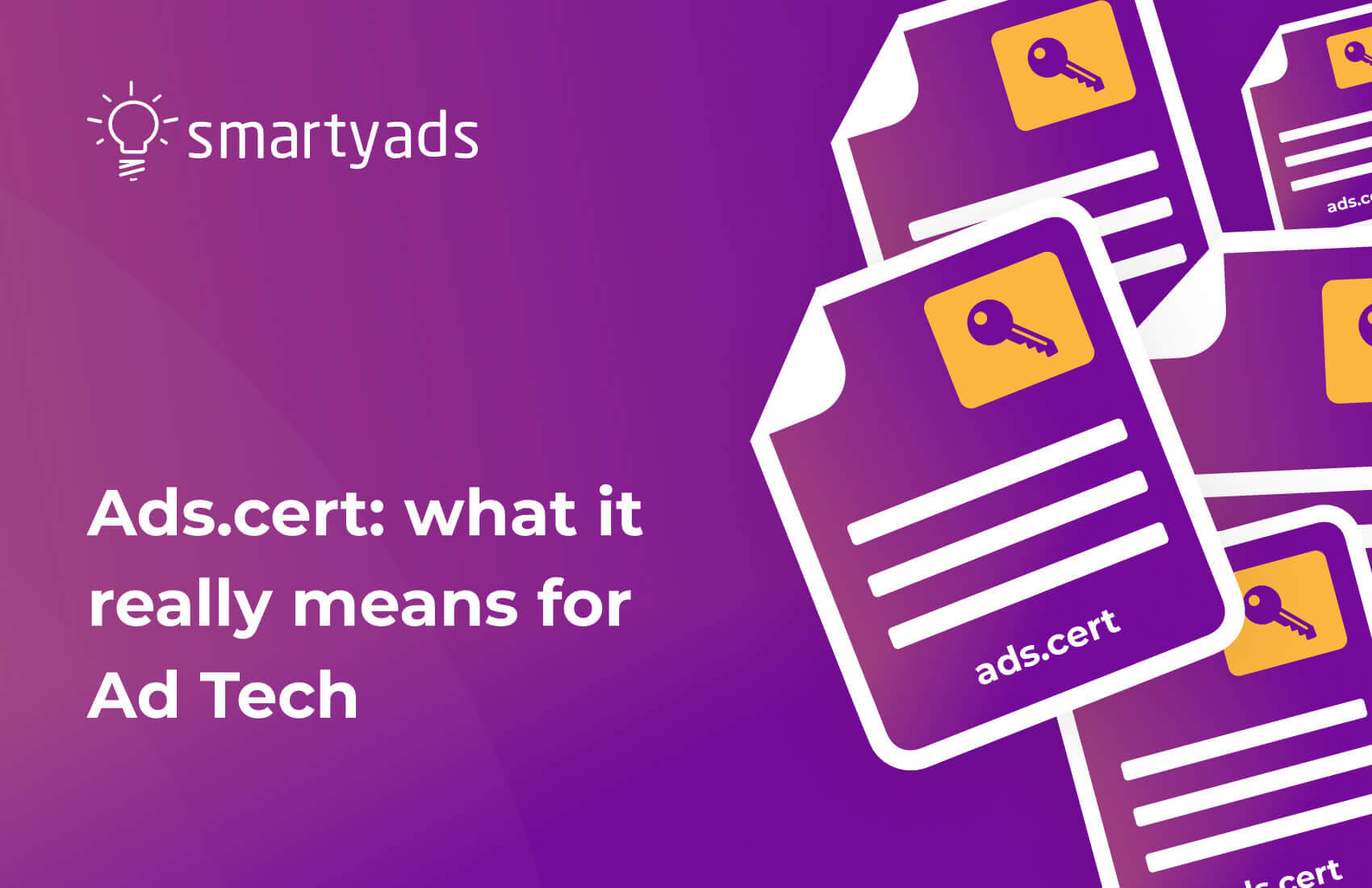As new IAB standard popped in, many ad tech players need clarification on what is ads.cert in order to stop confusing it with previous IAB standard: ads.txt. There’s a shared opinion that ads.cert is an improved version of ads.txt. Indeed, it serves the same anti-fraud purpose but in a completely different way.
While two of them are aimed to clean up supply chains, they actually work side by side complementing each other in functions. Ads.cert is a continuation of a massive IAB’s program against ad fraud that steps further towards effective digital inventory protection. So, let's steer things clear!
What is ads.cert and how does it work?
Ads.cert is an IAB’s standard aimed to authenticate digital inventory and validate details about it. It provides inventory assurances through cryptographically signed bid requests.
They authorize every bit of information (IP, device, geo, domain, page, and many other pieces of user data that determine the cost of impression.) exchanged between buyers and sellers at every stage of media-trading. Working as a digital signature, it helps buyers to ensure that inventory is legit and served exactly where it is reported to be. More about each step you’ll find in IAB Tech Lab’s documentation

Ads.txt helps advertisers to verify the traffic channel before purchasing. In the public ads.txt file, the publisher indicates all authorized traffic sellers. During the file revision advertiser can compare seller’s ID with positions featured in ads.txt on the publisher’s website. It is the responsibility of ads.txt to verify that each company has obtained permission from the publisher that they are authorized to sell.
Ads.cert, meanwhile, takes this to a new level by confirming all of the information that goes back and forth from seller to buyer at every step of the digital ad campaign. Therefore they work hand-in-hand.

Ads.cert enables the demand partners to validate numerous fields of the bid request and have a clear chain of custody. Ads.cert will now ask publishers to “sign” the “message” in order to confirm information about inventory. The signature combines all field values for the request:

According to recent statistics, 72% of the top 5000 websites that sell or buy programmatic ads are using ads.txt. Since Ads.txt has such great popularity among publishers, more and more advertisers are adjusting their campaigns to run on ads.txt verified sites. The same trend with ads.cert supposedly will be evident in a few months from now.
Why advertising ecosystem needs ads.cert
All of the signs are pointing to the fact, that ads.cert will become a mainstream standard sooner rather than later. Since it validates the information necessary for fair media trading, it bears the greatest importance for all ad market participants.
This initiative helps to completely remove problems associated with domain spoofing (when the request comes from one site, and the real display runs on another, poor-quality one). In this case, advertisers can be sure that ad is displayed in a safe environment. It also helps publishers: when their inventory is authorized, it will not be automatically banned by blacklists (in case of display principles violation).
Benefits of ads.cert for advertisers and publishers | |
Advertisers | Publishers |
The chance to advertise on authorized inventory. | Control over inventory. Elimination of unauthorized resellers. |
Eliminated budget waste on fraudulent impressions. | A chance to establish a reputation of a trustworthy partner. |
Verification of impression details in real-time. | More yields from advertisers who aim for authorized inventory only. |
Last challenges and future transition to ads.cert
Worth to mention, ads.cert only works with OpenRTB 3.0, so publishers who want to implement the new standard should look for vendors that support it. The real obstacle that’s left to overcome is the inertness of the ad market to changes. While standard adoption is not obligatory for implementation, not all publishers may consider it as a necessary measure.
The progress with adoption will depend on publishers and partly on technology vendors that must enforce the standard adoption and clearly explain why it is so important. Leading programmatic players already encourage ads.cert installation and provide publishers with comprehensive support in case they experience difficulties with ads.cert installation.
SmartyAds enforces ads.cert adoption
SmartyAds is always looking for innovative solutions to safeguard publishers and advertisers against ad fraud. That’s why we actively enforce the adoption of ads.cert on both supply-side platform for publishers and demand-side platform for advertisers.
Now media buyers are able to easily track the quality of impressions they are getting and make sure they are served in authorized, reliable, and fraud-free environments. Publishers, in their turn, can easily implement ads.cert standard on our OpenRTB 3.0-powered SSP platform and generate high-value verified traffic which translates into higher yields.
As a result, we are reducing the distance between the media buyers and media owners by letting them trade in a transparent, clear and fair ecosystem. Want to be among the first?




